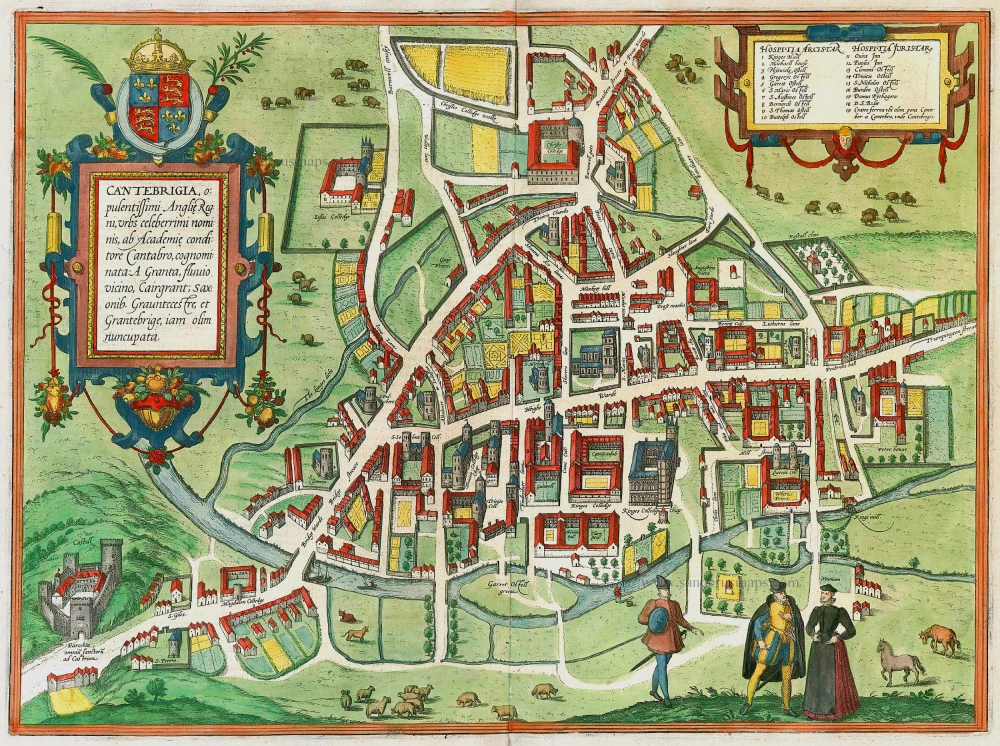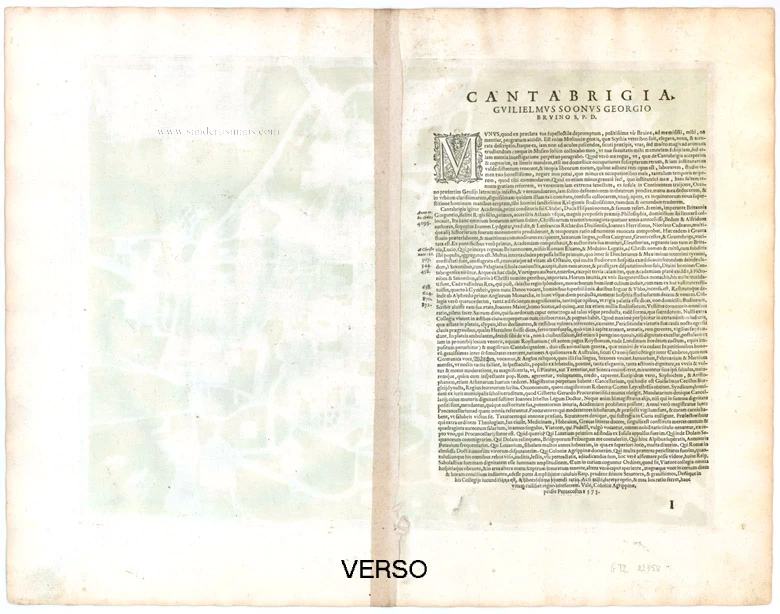Antique map - plan of Cambridge by Braun & Hogenberg. 1580
COMMENTARY BY BRAUN (on verso): "Up to the present day, Cambridge has 19 student houses, in addition to which 14 colleges have been built with such grandeur and magnificence that you might think they were royal palaces and not accommodation for students. In short, although I have travelled in many countries and seen many cities, I must admit that I have hardly ever seen anything comparable to this town and these schools, for everything is in such perfect order that nothing better could be imagined."
The engraving shows Cambridge from a birds-eye perspective. In 1209, professors and students from Oxford founded the University of Cambridge. In 1284, Hugh de Balsham, bishop of Ely, founded the first College, Peterhouse, visible on the far right of the engraving. Near the River Cam is one of the best-known colleges in the city. King Henry VI founded King's College in 1441. King's College Chapel, completed in 1515, is an important example of Gothic architecture and one of the city's chief landmarks. The castle is seen from a low perspective in the lower lefthand corner. The Normans built it in 1068, two years after the coronation of William I as king of England. It was demolished in the 19th century to provide building materials for new colleges. (Taschen)
Braun G. & Hogenberg F. and the Civitates Orbis Terrarum.
The Civitates Orbis Terrarum, also known as the 'Braun & Hogenberg', is a six-volume town atlas and the most excellent book of town views and plans ever published: 363 engravings, sometimes beautifully coloured. It was one of the best-selling works in the last quarter of the 16th century. Georg Braun, a skilled writer, wrote the text accompanying the plans and views on the verso. Many plates were engraved after the original drawings of a professional artist, Joris Hoefnagel (1542-1600). The first volume was published in Latin in 1572 and the sixth in 1617. Frans Hogenberg, a talented engraver, created the tables for volumes I through IV, and Simon van den Neuwel made those for volumes V and VI. Other contributors were cartographers Daniel Freese and Heinrich Rantzau, who provided valuable geographical information. Works by Jacob van Deventer, Sebastian Münster, and Johannes Stumpf were also used as references. Translations appeared in German and French, making the atlas accessible to a broader audience.
Since its original publication of volume 1 in 1572, the Civitates Orbis Terrarum has left an indelible mark on the history of cartography. Seven more editions followed the first volume in 1575, 1577, 1582, 1588, 1593, 1599, and 1612. Vol.2, initially released in 1575, saw subsequent editions in 1597 and 1612. The subsequent volumes, each a treasure trove of historical insights, graced the world in 1581, 1588, 1593, 1599, and 1606. The German translation of the first volume, a testament to its widespread appeal, debuted in 1574, followed by the French edition in 1575.
Several printers were involved: Theodor Graminaeus, Heinrich von Aich, Gottfried von Kempen, Johannis Sinniger, Bertram Buchholtz, and Peter von Brachel, all of whom worked in Cologne.
Georg Braun (1541-1622)
Georg Braun, the author of the text accompanying the plans and views in the Civitates Orbis Terrarum, was born in Cologne in 1541. After his studies in Cologne, he entered the Jesuit Order as a novice, indicating his commitment to learning and intellectual pursuits. In 1561, he obtained his bachelor's degree; in 1562, he received his Magister Artium, further demonstrating his academic achievements. Although he left the Jesuit Order, he continued his studies in theology, gaining a licentiate in theology. His theological background likely influenced the content and tone of the text in the Civitates Orbis Terrarum, adding a unique perspective to the work.
Frans Hogenberg (1535-1590)
Frans Hogenberg was a Flemish and German painter, engraver, and mapmaker. He was born in Mechelen as the son of Nicolaas Hogenberg.
By the end of the 1560s, Frans Hogenberg was employed upon Abraham Ortelius's Theatrum Orbis Terrarum, published in 1570; he is named an engraver of numerous maps. In 1568, he was banned from Antwerp by the Duke of Alva and travelled to London, where he stayed a few years before emigrating to Cologne. He immediately embarked on his two most important works, the Civitates, published in 1572 and the Geschichtsblätter, which appeared in several series from 1569 until about 1587.
Thanks to large-scale projects like the Geschichtsblätter and the Civitates, Hogenberg's social circumstances improved with each passing year. He died as a wealthy man in Cologne in 1590.
Cantebrigia, Opulentissimi Angliae Regni ...
Item Number: 22358 Authenticity Guarantee
Category: Antique maps > Europe > British Isles
Antique map - plan of Cambridge by Braun & Hogenberg.
Title: Cantebrigia, Opulentissimi Angliae Regni ...
Date of the first edition: 1575.
Date of this map: 1580.
Copper engraving, printed on paper.
Size (not including margins): 330 x 445mm (12.99 x 17.52 inches).
Verso: Latin text.
Condition: Old coloured, excellent.
Condition Rating: A.
From: Civitates Orbis Terrarum, Liber Secundus. Köln, Gottfried von Kempen, 1580. (Van der Krogt 4, 41:1.2)
COMMENTARY BY BRAUN (on verso): "Up to the present day, Cambridge has 19 student houses, in addition to which 14 colleges have been built with such grandeur and magnificence that you might think they were royal palaces and not accommodation for students. In short, although I have travelled in many countries and seen many cities, I must admit that I have hardly ever seen anything comparable to this town and these schools, for everything is in such perfect order that nothing better could be imagined."
The engraving shows Cambridge from a birds-eye perspective. In 1209, professors and students from Oxford founded the University of Cambridge. In 1284, Hugh de Balsham, bishop of Ely, founded the first College, Peterhouse, visible on the far right of the engraving. Near the River Cam is one of the best-known colleges in the city. King Henry VI founded King's College in 1441. King's College Chapel, completed in 1515, is an important example of Gothic architecture and one of the city's chief landmarks. The castle is seen from a low perspective in the lower lefthand corner. The Normans built it in 1068, two years after the coronation of William I as king of England. It was demolished in the 19th century to provide building materials for new colleges. (Taschen)
Braun G. & Hogenberg F. and the Civitates Orbis Terrarum.
The Civitates Orbis Terrarum, also known as the 'Braun & Hogenberg', is a six-volume town atlas and the most excellent book of town views and plans ever published: 363 engravings, sometimes beautifully coloured. It was one of the best-selling works in the last quarter of the 16th century. Georg Braun, a skilled writer, wrote the text accompanying the plans and views on the verso. Many plates were engraved after the original drawings of a professional artist, Joris Hoefnagel (1542-1600). The first volume was published in Latin in 1572 and the sixth in 1617. Frans Hogenberg, a talented engraver, created the tables for volumes I through IV, and Simon van den Neuwel made those for volumes V and VI. Other contributors were cartographers Daniel Freese and Heinrich Rantzau, who provided valuable geographical information. Works by Jacob van Deventer, Sebastian Münster, and Johannes Stumpf were also used as references. Translations appeared in German and French, making the atlas accessible to a broader audience.
Since its original publication of volume 1 in 1572, the Civitates Orbis Terrarum has left an indelible mark on the history of cartography. Seven more editions followed the first volume in 1575, 1577, 1582, 1588, 1593, 1599, and 1612. Vol.2, initially released in 1575, saw subsequent editions in 1597 and 1612. The subsequent volumes, each a treasure trove of historical insights, graced the world in 1581, 1588, 1593, 1599, and 1606. The German translation of the first volume, a testament to its widespread appeal, debuted in 1574, followed by the French edition in 1575.
Several printers were involved: Theodor Graminaeus, Heinrich von Aich, Gottfried von Kempen, Johannis Sinniger, Bertram Buchholtz, and Peter von Brachel, all of whom worked in Cologne.
Georg Braun (1541-1622)
Georg Braun, the author of the text accompanying the plans and views in the Civitates Orbis Terrarum, was born in Cologne in 1541. After his studies in Cologne, he entered the Jesuit Order as a novice, indicating his commitment to learning and intellectual pursuits. In 1561, he obtained his bachelor's degree; in 1562, he received his Magister Artium, further demonstrating his academic achievements. Although he left the Jesuit Order, he continued his studies in theology, gaining a licentiate in theology. His theological background likely influenced the content and tone of the text in the Civitates Orbis Terrarum, adding a unique perspective to the work.
Frans Hogenberg (1535-1590)
Frans Hogenberg was a Flemish and German painter, engraver, and mapmaker. He was born in Mechelen as the son of Nicolaas Hogenberg.
By the end of the 1560s, Frans Hogenberg was employed upon Abraham Ortelius's Theatrum Orbis Terrarum, published in 1570; he is named an engraver of numerous maps. In 1568, he was banned from Antwerp by the Duke of Alva and travelled to London, where he stayed a few years before emigrating to Cologne. He immediately embarked on his two most important works, the Civitates, published in 1572 and the Geschichtsblätter, which appeared in several series from 1569 until about 1587.
Thanks to large-scale projects like the Geschichtsblätter and the Civitates, Hogenberg's social circumstances improved with each passing year. He died as a wealthy man in Cologne in 1590.






